Sunday, October 29, 2006
Sidbury and Fort Royal Conservation Area
Worcester City Council published a document on the Sidbury and Fort Royal Conservation Area and it's available on line. A good summary of historical data and proposals for change.
Wednesday, August 02, 2006
Thank you for your feedback
There have been lots of comments on this blog, so thank you to everyone who took the trouble. If anyone was put off by having to register on Blogger, sorry for not getting the comment settings right first time, but I have done it now.Anyone can comment now, withour registering!
I thought Laura's comment was worth repeating in a main entry, so here it is:
Laura said...
Thanks for all the fantastic photos over the last few weeks - I've enjoyed reading your experiences of the excavation.
Wouldn't it be wonderful if this kind of community excavation could be repeated each year - I met so many people who had heard too late about the dig to get the chance to volunteer - for instance those of us with young kids have to get there while the dears are still at school and we may get the chance to throw a sickie - (no not really Simon!) There's a demand - I only hope it can be met in future years.
P.S. Don't think about the winter guys - volunteers do not get paid for freezing their fingers off!
And Julian found a copy of the BBC video clip at http://www.youtube.com/watch?v=zDR6-kvAVf4
I thought Laura's comment was worth repeating in a main entry, so here it is:
Laura said...
Thanks for all the fantastic photos over the last few weeks - I've enjoyed reading your experiences of the excavation.
Wouldn't it be wonderful if this kind of community excavation could be repeated each year - I met so many people who had heard too late about the dig to get the chance to volunteer - for instance those of us with young kids have to get there while the dears are still at school and we may get the chance to throw a sickie - (no not really Simon!) There's a demand - I only hope it can be met in future years.
P.S. Don't think about the winter guys - volunteers do not get paid for freezing their fingers off!
And Julian found a copy of the BBC video clip at http://www.youtube.com/watch?v=zDR6-kvAVf4
Sunday, July 30, 2006
Last Pictures
These, I'm afraid, are my last pictures. If you have any you want to see on this blog, please shrink them to 300-400 pixels across and email them to me fortroyal1651@yahoo.co.uk with details. Sorry to archaeologists, volunteers, Commandery staff, members of the public and press photographers who I may have walked into, got in the way of or included in the background of pictures without their permission. And thank you to everyone. It's been a fascinating experience.
Looking at a piece of ground, you try to guess what might be underneath, but you are rarely right. Who would have thought that there was so much fill put into the garden in the last couple of centuries that in places we would never get down to older levels in the time we had? Or that such a magnificent wall was only centimetres under the ground at Trench 7?
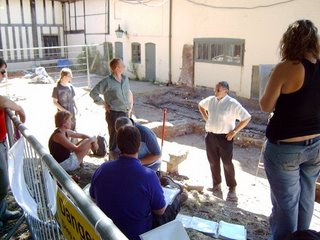



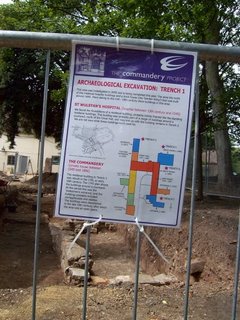
Can we do it again next year please?
Looking at a piece of ground, you try to guess what might be underneath, but you are rarely right. Who would have thought that there was so much fill put into the garden in the last couple of centuries that in places we would never get down to older levels in the time we had? Or that such a magnificent wall was only centimetres under the ground at Trench 7?





Can we do it again next year please?
Working up to the BBQ
Friday was the last weekday of the dig, and the team said thank you to the volunteers by putting on a barbecue (well done Angus and Christine) where we got together with some of those people we've worked with for a while over the last few weeks. Justin presented us all with certificates, well he put them on a chair and we helped ourselves, but it saves a lot of clapping, and it was hot. Somebody dug up a barrel of beer and a few bottles of wine - amazing finds on this site - together with orange juice for the work experience trainees and other teetotallers. I thought it best not to take embarrassing pictures of people drinking, so these pictures were taken shortly before, while inspectors from English Heritage were admiring our prize feature, the double sandstone mediaeval wall.










Friday, July 28, 2006
Volunteers all
It was on another dig that the mutinous volunteers were offered a 5% increase in pay.
"You don't fool us," they said "5% of nothing is nothing! We want 10% or else."
That's my volunteer joke. I don't know any archaeological jokes. It's a very serious business down those holes.
Here are some of the unpaid volunteers. Sorry to those whose pictures I took but didn't include. Some of the film didn't come out properly. Probably because it was a digital camera.

The girls are not idling, but watching an excellent demonstration of the hazardous job of mattocking.

Julian Swinbourne the poet with the tools of his other trade.
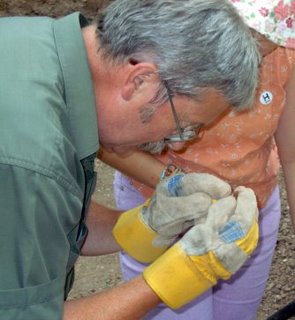
Those yellow gloves are a wonderful safety feature when the weather is cloudy. We tried photographing the Roman pottery on them, but they outshone the finds too much, so we used a kneepad instead. (Can someone send a comment identifying what they are please?) Here are the details I asked for: clockwise from top left: Black Burnished, Severn Valley Ware, Samian Ware, Mortarium - all from 120 - 200 AD. They are from a dumped layer, so are unlikely to originate on the site, perhaps having been brought with the earth down the new canal to fill low-lying land. They were probably worried about this new-fangled canal flooding the site.

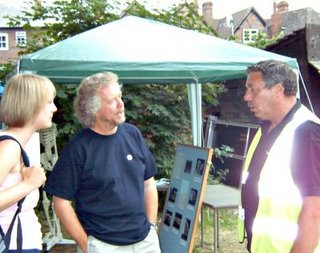
Lots of visitors turned out on Saturday for the celebrity appearance by Julian Richards, from BBC TV's Meet the Ancestors. Most of the volunteers were hard at work, but one or two found time to schmooze. I tried to get on Meet the Ancestors once, but they would only consider me for a part as one of the ancestors. As one volunteer said, meeting the in-laws was bad enough, never mind the ancestors.
"You don't fool us," they said "5% of nothing is nothing! We want 10% or else."
That's my volunteer joke. I don't know any archaeological jokes. It's a very serious business down those holes.
Here are some of the unpaid volunteers. Sorry to those whose pictures I took but didn't include. Some of the film didn't come out properly. Probably because it was a digital camera.

The girls are not idling, but watching an excellent demonstration of the hazardous job of mattocking.

Julian Swinbourne the poet with the tools of his other trade.

Those yellow gloves are a wonderful safety feature when the weather is cloudy. We tried photographing the Roman pottery on them, but they outshone the finds too much, so we used a kneepad instead. (Can someone send a comment identifying what they are please?) Here are the details I asked for: clockwise from top left: Black Burnished, Severn Valley Ware, Samian Ware, Mortarium - all from 120 - 200 AD. They are from a dumped layer, so are unlikely to originate on the site, perhaps having been brought with the earth down the new canal to fill low-lying land. They were probably worried about this new-fangled canal flooding the site.


Lots of visitors turned out on Saturday for the celebrity appearance by Julian Richards, from BBC TV's Meet the Ancestors. Most of the volunteers were hard at work, but one or two found time to schmooze. I tried to get on Meet the Ancestors once, but they would only consider me for a part as one of the ancestors. As one volunteer said, meeting the in-laws was bad enough, never mind the ancestors.
Thursday, July 27, 2006
Finds

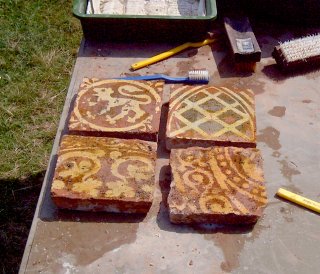


I can wash up at home any time I like, so finds washing has little attraction for me, but a small band of loyal washers has been supplemented by lots of extra volunteers, particularly during the heat. They wash and scrub the pots, bones and tiles, then mark them with the identifier for the context they come from, that's the level and location of soil they are found in. As well as being pretty to look at, and being the justification for digging that we need for the builders: "Found any gold yet?", they help to date the features that we find. Finally, the whole band of diggers, the tools, health forms, documentation, toilets and Jaffa Cakes which support the dig, not to mention the day by day professional decisions, are managed brilliantly by Justin, the dig boss. He doesn't pose for photos, it makes him break up laughing, but I got him while he was measuring.
Mysterious walls in the Canal Trench
It's in the last few days of the dig that the really promising structures have come to light in the canal trench, but there is little time left to investigate this collection of walls lying closely against each other horizontally and vertically. They are certainly mediaeval, and must be part of the original hospital. The last picture is of the gallant garden trench workers, who have had lots of mixed finds, but no structures for all their hard work.

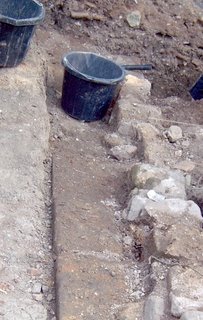








Digging Deeper
It's only hot today at the dig, instead of unbearably hot. I could smell the sun screen in the trenches - well I think it was sun screen. The mediaeval wall that might be St Gudwal's Chapel is several courses deep and has a star-shaped mason's mark - a sort of trade mark - which matches one in Worcester Cathedral.
 Pictures below: The wall;
Pictures below: The wall;
 Holding the measuring pole for levelling;
Holding the measuring pole for levelling;
 Planning features on a grid;
Planning features on a grid;
 Gathering more earth in a bucket to empty on a growing spoil heap;
Gathering more earth in a bucket to empty on a growing spoil heap;
 Levelling, ie finding the height above sea level of the features;
Levelling, ie finding the height above sea level of the features;
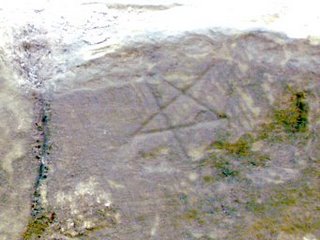 The mason's mark;
The mason's mark;
 Where the mason's mark is carved;
Where the mason's mark is carved;
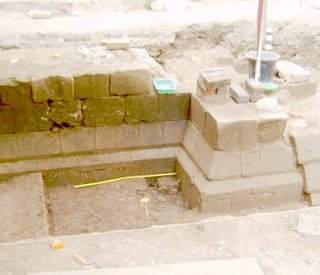
 Pictures below: The wall;
Pictures below: The wall; Holding the measuring pole for levelling;
Holding the measuring pole for levelling; Planning features on a grid;
Planning features on a grid; Gathering more earth in a bucket to empty on a growing spoil heap;
Gathering more earth in a bucket to empty on a growing spoil heap; Levelling, ie finding the height above sea level of the features;
Levelling, ie finding the height above sea level of the features; The mason's mark;
The mason's mark; Where the mason's mark is carved;
Where the mason's mark is carved;
Saturday, July 22, 2006
Sorry!
I have to apologise for my absence from the dig this week. The heat was too much for me, and I had some work I could do indoors. I have managed to get a few photos, though. The Chapel wall has come on a treat, and the real mediaeval wall under those "mediaeval gateway" cesspits in the Canal trench looks great. The pit is so deep that I took several photos before I noticed anyone was down there!






Sunday, July 09, 2006
It's off to work we go
One reader of this blog (yes, it does have readers other than yourself) commented that there seem to be a lot of people watching while one person or less is actually working. Let's nail this rumour that we are idling about.

First, although the professional archaeologists are often observing rather than digging, this is some of what they are supposed to do:
This particular group were watching one volunteer work because they were posing for a photograph, which is another frequent occurrence.

First, although the professional archaeologists are often observing rather than digging, this is some of what they are supposed to do:
- ensure that we are working safely, not stabbing each other with trowels, falling into trenches full of water or puncturing gas mains
- keeping the work scientifically accurate, for instance making sure earth, and therefore finds are not falling from modern layers to mediaeval layers, thereby losing the proof that it is a mediaeval layer.
- working out what to do next based on what the features might represent, and what we might find by digging out another layer in this particular corner.
- they are learning how to do something
- they are listening to the archaeologists debating a hot concern about dating or identifying gatehouses from cesspits
- they are tired from this unfamiliar manual work
- no one is paying us, we'll stop when we damn well like!
This particular group were watching one volunteer work because they were posing for a photograph, which is another frequent occurrence.
Saturday, July 08, 2006
Flash flood delays progress

Very severe rainfall on Wednesday evening caused flash flooding in many parts of Worcester, with several roads being inundated because the drains were full. The recent dry weather had made the ground hard, so that runoff was fast and uncontrollable. Stanley Road, Dent Close, Wylds Lane and City Walls Road and Sidbury were among those affected in the Fort Royal area. The canal overflowed its towpath at Sidbury Lock, affecting the Kings Head pub, which was also suffering flooding from the wash caused by vehicles negotiating floodwater on the carriageway. The Worcester News has a report and BBC Hereford and Worcester has pictures.
The Commandery dig site was waterlogged, and part was completely flooded for a while, so little was done on Thursday, and Friday morning was spent getting rid of silt and gravel which had fallen into the trenches.

Proof of the flooding was in the trench nearest the canal. A fish had been washed into it, and the water had gone down again before it could swim back into the canal. Tragically, nothing could be done to save it, and it was buried with full archaeological honours on the spoil heap. A suitable gravestone was erected during our morning break.




Thanks for the link!

The official diary of the Commandery dig is not only linking to this blog, but has a picture of me on it! Click on the picture to see Dig Diary.
Tuesday, July 04, 2006
More Commandery Dig Pictures
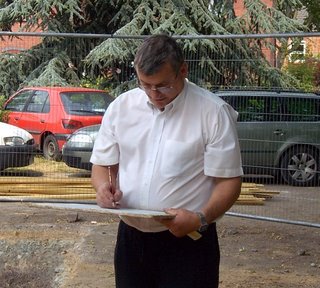 Everything is written down and drawn on a plan. We also take levels with a theodolite and take photos with a digital camera. The information gathered of where exactly everything was in every layer of earth is as useful as the finds, and takes much longer than the digging.
Everything is written down and drawn on a plan. We also take levels with a theodolite and take photos with a digital camera. The information gathered of where exactly everything was in every layer of earth is as useful as the finds, and takes much longer than the digging. 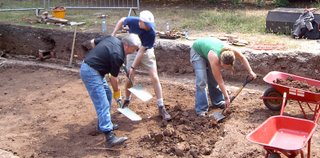 Though sometimes we dig with shovels.
Though sometimes we dig with shovels.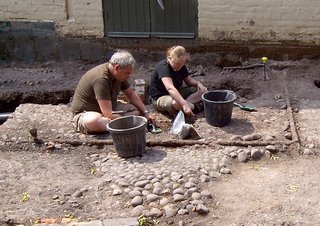 ... and there is endless cleaning with a trowel to get a surface where the differences in soil colour and texture can easily be seen.
... and there is endless cleaning with a trowel to get a surface where the differences in soil colour and texture can easily be seen.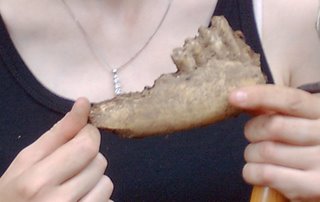 This probably a sheep jawbone. It's definitely not human.
This probably a sheep jawbone. It's definitely not human. ...but we are still proud of everything we find ...
...but we are still proud of everything we find ... ... and wash it carefully, without a dishwasher.
... and wash it carefully, without a dishwasher.
Monday, July 03, 2006
The Commandery Museum
Worcester City Council's The Commandery web site is also following the excavation, and its staff are busy educating and entertaining hordes of schoolchildren.
Subscribe to:
Posts (Atom)

